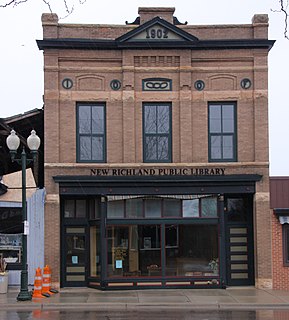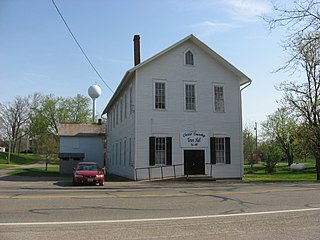
This is a list of the National Register of Historic Places listings in Erie County, Ohio.
Odd Fellows Hall, Independent Order of Odd Fellows Building, IOOF Building, Odd Fellows Lodge and variations are buildings for a chapter of the Independent Order of Odd Fellows fraternal organization.

The Ancient Free and Accepted Masons Lodge 687, also known as the Independent Order of Odd Fellows J.R. Scruggs Lodge 372, is a building constructed in 1876 as a Masonic Hall. It is located in downtown Orangeville, Illinois, a small village in Stephenson County. The building, originally built by the local Masonic Lodge, was bought by the locally more numerous Independent Order of Oddfellows fraternal organization in 1893. The building has served all of Orangeville's fraternal organizations for more than 125 years, from the time it was built. The two-story, front gabled building has Italianate architecture elements. It had a rear wing added to it in 1903. By 2003, the first floor has been returned to use as a community center, holding dinner theatre and other community functions, much as the building had originally served the community until first floor space was rented out for commercial use in the late 19th century. The building was listed on the U.S. National Register of Historic Places in 2003. The building is the home of the Mighty Richmond Players Dinner Theatre (MRPDT) dinner theatre which seats 54 persons and has scheduled four different productions for the 2010 season. A $150,000 renovation of the building was recently completed. The building was listed on the National Register of Historic Places as AF and AM Lodge 687, Orangeville in 2003.

The former Odd Fellows Hall, located at 536 Massachusetts Avenue in Cambridge, Massachusetts, in the United States, is a historic building built in 1884 by members of the Independent Order of Odd Fellows. On April 13, 1982, it was added to the National Register of Historic Places. It is now The Dance Complex, founded by Rozann Kraus in 1991.

The Odd Fellows Building and Auditorium, located at 228—250 Auburn Avenue, N.E. in the Sweet Auburn Historic District of Atlanta, Georgia, are historic buildings built in 1912 and 1913, respectively, as the headquarters of the District Grand Lodge No. 18, Jurisdiction of Georgia, of the Grand United Order of Odd Fellows in America. B.S. Ingram was District Grand Master and Dr. William F. Penn was chairman of the building committee. Renowned Atlanta-based architect William Augustus Edwards designed the buildings, while Robert E. Pharrow was the contractor and M.B. Morton was superintendent of construction. Booker T. Washington dedicated the Odd Fellows Building in 1912.

The Odd Fellows' Hall is a historic Odd Fellows' hall at 1-5 State Street on the Buckland side of Shelburne Falls, Massachusetts. Built in 1877, and rebuilt after a damaging fire in 1895, it has been a focal point of the business district on the Buckland side of the village since its construction, serving an active Odd Fellows chapter until 1963. The building was listed on the National Register of Historic Places in 1979. In 1988 it was included in the Shelburne Falls Historic District.

The Clark Memorial Hall, also known as the Adrian I.O.O.F. Hall, is a commercial building located at 120–124 South Winter Street (M-52) in the Downtown Adrian Commercial Historic District in Adrian, Michigan. It was designated as a Michigan Historic Site and individually listed on the National Register of Historic Places on January 14, 1985.

The Masonic Temple is a historic Masonic temple in the village of Mechanicsburg, Ohio, United States. Built in the 1900s for a local Masonic lodge that had previously met in a succession of buildings owned by others, it is the last extant Mechanicsburg building constructed for a secret society, whether Masonic or otherwise, and it has been designated a historic site because of its well-preserved American Craftsman architecture.

The Wyandotte Odd Fellows Temple is a community building located at 81 Chestnut Street in Wyandotte, Michigan. It was listed on the National Register of Historic Places in 2009. As of 2010, the building serves as the Wyandotte Arts Center.

The Independent Order of Odd Fellows Hall in Ashton, Idaho, also known as the Ashton State Bank Building was built in 1907 in Early Commercial architectural style. It served historically as a meeting hall and for businesses. It was listed on the National Register of Historic Places in 1997.
The IOOF Lodge No. 355, also known as the Clements Odd Fellows Hall, in Clements, California is a two-story brick building that was listed on the National Register of Historic Places in 2007.

The Fullerton Odd Fellows Temple, also known as IOOF Building or Independent Order of Odd Fellows Lodge No.103 or Williams Building, is located in Fullerton, Orange County, California. It was designed by Oliver S. Compton-Hall and built during 1927-28 for the Independent Order of Odd Fellows Lodge Number 103, which existed from 1901 to 1981.

The IOOF Liberty Lodge No. 49, built in 1923, is a historic commercial building in Liberty, Missouri. It served historically as an Independent Order of Odd Fellows meeting hall and as a specialty store. The building was listed on the National Register of Historic Places in 1992.

The New Richland Odd Fellows Hall is a historic Independent Order of Odd Fellows (IOOF) clubhouse in New Richland, Minnesota, United States, built in 1902. It was listed on the National Register of Historic Places in 2006 under the name Strangers Refuge Lodge Number 74, IOOF for its local significance in the themes of entertainment/recreation and social history. It was nominated for being the home of a large and important local fraternal organization, and for serving as a venue for a wide range of other groups and events. The building now houses the New Richland Public Library.

The Chester Town Hall is a historic governmental building and community meeting place in the village of Chesterville, Ohio, United States. Built in the 1860s by the village and a fraternal society, it has served as home for both entities throughout its history, as well as providing space for Chester Township officials and community gatherings. Along with numerous other buildings in the village, it has been named a historic site.

The former I.O.O.F. Hall, located at 613-615 Iowa Avenue in the original commercial block of Dunlap, Harrison County, Iowa, is an historic two-story pedimented red-brick building built for local members of the Independent Order of Odd Fellows. Also known as the Odd Fellows Hall, it was used by Golden Rule Lodge No. 178, IOOF founded in 1869 and Guiding Star Encampment No. 68, IOOF, a higher body founded in 1874. Like many American lodge halls of the late 19th and early 20th centuries, it had business and commercial space on the ground floor while the lodge hall was upstairs. In 2009 it was renovated for its owner Brad Gross, CPA, who now uses it for his professional office. On June 23, 2011, it was added to the National Register of Historic Places.

George Feick was a German-American builder in Sandusky and Oberlin, Ohio. His works include the Wyoming State Capitol, multiple buildings at Oberlin College, and numerous office buildings, churches, schools, libraries and residences in and around Sandusky. Several of his works are listed on the National Register of Historic Places.

The Ursa Town Hall, also known as the Ursa Odd Fellows Lodge, is a historic building located at 109 South Warsaw Street in Ursa, Illinois. The building was constructed in 1895; from its completion, it was intended to serve both as Ursa's town hall and as a meeting place for the local lodges of the Independent Order of Odd Fellows and the Freemasons. The Odd Fellows funded the building and owned the hall, lending space to the other groups; however, Ursa Township eventually purchased the first floor of the building, as the Odd Fellows only met on the upper floor per the order's custom. The town used the lower floor for its meetings and as a polling place; the meeting space has also held school events, as the local school lacked an auditorium, and business meetings. The hall also served as the community's social center; the Odd Fellows hosted many community events, and residents watched traveling performers and movies in the hall.

The Barnes Building, originally known as the Odd Fellows' Block, the Masonic Temple from 1909 to 1915, and later Ingram Hall, is a historic fraternal and office building located at 2320-2322 1st Avenue in the Belltown neighborhood of Seattle, Washington. Designed in early 1889 and constructed in late 1890 by Seattle Lodge No. 7 of the International Order of Odd Fellows and designed for use by all of the city's Odd Fellow lodges, it is the earliest known surviving work of Seattle architect William E. Boone and George Meeker and remains in an almost perfect state of preservation. The Barnes building has played an important role in the Belltown Community and Seattle's dance community. It was used by the Odd Fellows for 17 years before their departure to a newer, bigger hall in 1909 and was home to a variety of fraternal & secret societies throughout the early 20th century, with the Free and Accepted Masons being the primary tenant until their own Hall was built in 1915. The ground floor has been a host to a variety of tenants since 1890 ranging from furniture sales to dry goods to farm implement sales and sleeping bag manufacturing, most recently being home to several bars. It was added to the National Register of Historic Places as The Barnes Building on February 24, 1975.





















